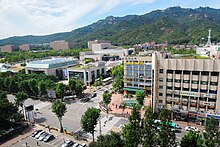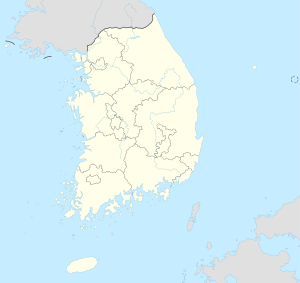Gwacheon
| Gwacheon | |||
|---|---|---|---|
| Korean alphabet : | 과천시 | ||
| Chinese characters : | 果 川 市 | ||
| Revised Romanization : | Gwacheon-si | ||
| McCune-Reischauer : | Kwach'on-si | ||
| Basic data | |||
| Province : | Gyeonggi-do | ||
| Coordinates : | 37 ° 27 ' N , 127 ° 0' E | ||
| Surface: | 35.86 km² | ||
| Residents: | 72,088 (as of 2010) | ||
| Population density : | 2,010 inhabitants per km² | ||
| Structure: | 2 gu, 31 dong | ||
| map | |||
|
|||
Gwacheon is a city in Gyeonggi-do Province in South Korea . It is a satellite city of Seoul . About 25 km south of the capital, it is located in the center of the metropolitan area of Sudogwon and northeast of the city of Anyang . Since 1982 the city served as a government district and housed a government complex. Until 2012 it was the location of seven ministries before the majority moved to Sejong .
Various attractions associated with Seoul, including the Seoul Grand Park , the National Museum of Contemporary Art , the Seoul Land Amusement Park , the Gwacheon National Science Museum and the Seoul Race Park , are located in the city of Gwacheon. Several administrative centers of the Korean government can also be found here, which have their own subway station called Gwacheon Government Complex .
The Line 4 subway Seoul crosses the city with five holding stations.
history
In the year 475 the place was incorporated as Yulmok-gun into the administrative system of Goguryeo under King Jangsu. Under King Taejo of Goryeo , then called King Wang Geon, the place rose to a more important administrative unit in 940 and was renamed Gwaju (과주, 果 州). In the course of an administrative reformation, the place was named Gwacheon-hyeon (과천현, 果 川 縣). Gwacheon later changed status several times but has kept the name to this day.
In 1986 Gwacheon was granted city status.
Characteristic

Gwacheon has a modern city center with shops, hotels, many restaurants and a main fire station. The town hall with integrated sports halls and kindergartens is also very central. The more than 70,000 inhabitants live mainly in modern high-rise buildings with up to 25 floors.
The Department of Justice is located in Building No. 5 within the Gwacheon Government Complex and the Korean Communications Commission is located in Building No. 2.
The Seoul Grand Park and Mount Gwanak ( Gwanaksan ) cover most of the city area. The mountain landscape and the forests shape the image of the popular excursion destination.
Attractions
Several historically valuable buildings have been preserved in Gwacheon. These include the Gwacheon Hyanggyo (Korean Confucianism Institute, built 1389) and the YeonJu Temple , built on a rocky outcrop. In addition, the three-tiered YeonJuAhm Pagoda and the portrait of Hyo-ryung, the second son of King Taejong , are listed as cultural assets of the Gyeonggi-do Province . This includes the map of Joseon , which is kept at the Ministry of Korean History as a national treasure.
In Korea's past, Gwacheon was not only a place of tranquility and beautiful scenery, but also an important center for the education and religion of kings .
The first foreign language university in Gyeonggi-do Province is located in the Jongang-dong district. Gwacheon has a science and technology center and one of the largest public libraries in Gyeonggi-do Province.
The Seoul Grand Park houses a zoo and a children's zoo, the SeoulLand amusement park , a rose garden and the contemporary art museum.
The zoo is the oldest in Korea and the tenth largest in the world. It was founded on November 1st, 1909 by Japanese occupiers in the Changgyeonggung Royal Palace . At the end of the First World War , the Japanese occupiers ordered the killing of all animals because they needed the metal of the cages for armor. After the liberation of Korea, the zoo stayed there until 1984 when it was relocated to the Makgyedon district and greatly expanded.
Like the Seoul Grand Park , the racecourse and the new National Science Museum ( Gwacheon National Science Museum ) have a subway station. The museum was opened in 2008 and is under construction based on the model of the Deutsches Museum in Munich (largest natural science and technology museum in the world).
Gwacheon Festival
The festival for street theater and street art, founded in 1997, is based in the city. In 2012 the name was changed from Hanmadang Festival to Gwacheon Festival . Traditional Korean theater is presented in the streets at the end of September under the artistic direction of Yim Su-taek, as well as modern productions of theater, music, visual arts and dance by groups from all over the world. Many French and German groups, such as B. the Titanick Theater , Generik Vapeur and Makadam Kanibal, have already made guest appearances in the city. Usually there are 20 Korean and 10 guest groups from other countries who play in front of an audience of 100,000 around the town hall and in the nearby Jeongja Park .
Artistic director Yim Su-taek (left) of the Gwacheon festival together with Khuon Det (right), the artistic director of Phare Ponleu Selpak (Art and Circus School in Battambang, Cambodia)
traffic
Subway line 4 (from Seochu-gu Seoul to Ansan and Oido) runs right through Gwacheon and stops at five stations (Seonbawi, Seoul-Racecourse-Park, Seoul-Grand-Park, Gwacheon and Government-Complex-Gwacheon) on theirs 75 kilometer long journey across the metropolitan area of Seoul from north to south with its 60 stations. Gwacheon is connected to Incheon International Airport and Gimpo Airport by direct bus . Local buses run to surrounding towns and the world heritage city of Suwon .
The . No Highway 1 (Seoul - Busan ) affected Gwacheon east three kilometers away. The highways 100 and 171 can also be reached quickly.
Gwacheon is not connected to the railway network.
Twin cities
![]() Airdrie , Canada Nanning , People's Republic of China Shirahama , Japan Burlington (North Carolina) , USA
Airdrie , Canada Nanning , People's Republic of China Shirahama , Japan Burlington (North Carolina) , USA
![]()
![]()
![]()
Personalities
- Kim Dong-chan (* 1986), soccer player
- Kim Seok-jin (* 1992), singer
Individual evidence
- ↑ Korea at a glance: South Korea on visitkorea.or.kr. Retrieved December 23, 2012.
- ^ Website of the South Korean Ministry of Justice . Retrieved June 11, 2013.
- ^ Website of the Korean Communications Commission . Retrieved June 11, 2013.
- ↑ Seoul Grand Park (서울대 공원) on visitkorea.or.kr. Retrieved December 23, 2012.
- ↑ When A Korean Royal Palace was A Zoo on rokdrop.com April 23, 2009. Retrieved December 25, 2012.
- ↑ Seoul Racecourse (서울 경마 공원) on visitkorea.or.kr. Retrieved December 23, 2012.
- ↑ Official homepage of the festival . Retrieved May 30, 2016 (Korean)
- ↑ Jin (BTS) Facts and Profile (Updated!). In: Kpop Profiles. September 1, 2016, accessed April 30, 2020 (American English).







